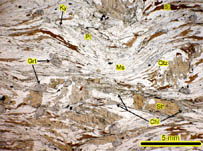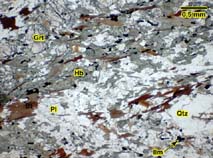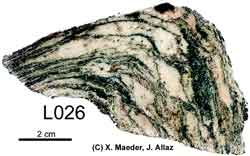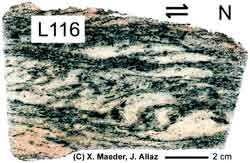| Amphibolites*
(in its broad sens, figure on the right) are composed of alternation
of massive amphibolites (in the strict sens with often more than
75%
amphibole)
and paragneiss
with amphibole (right figure). The amphibolite (strict sens) shows
a mineral
assemblage* with green hornblend (tschermakite), garnet, plagioclase
(15-45% anorthite) and biotite. The local retromorphosis*
of those rocks lead to the formation of epidote-calcite-chlorite assemblage.
|
Finally, augen
gneiss* (figure below) are formed of feldspars porphyroblasts
(plagioclases [8-25% anorthite] and K-feldspars), quartz and two micas
(muscovite and
biotite). In the
border, porphyroblasts tend to disappear, leaving place to a leucocratic*
facies, called border facies (light rose in
the geological
map). This facies
is formed by a top to the North shearing*
linked to the nappes*
emplacement (see next page). |





